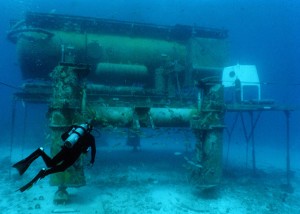
The Aquarius underwater habitat and laboratory (Credit: NOAA's Undersea Research Center at the University of North Carolina Wilmington)
It’s called a “science splashdown.”
The undersea environment is the closest analogue on Earth to a gravity-weak environment like that of asteroids, the moons of Mars or Mars itself.
Therefore, other than being in outer space, going to inner-space is the best place to test relevant exploration concepts.
The NASA Extreme Environment Mission Operations, known as NEEMO, sends groups of astronauts, engineers, doctors and professional divers to live in Aquarius.
Aquarius is an underwater habitat located about 60 feet (19 meters) below the surface, some 3 miles (5.6 kilometers) off Key Largo in the Florida Keys.
NEEMO 19 is a 7-day mission that started September 7 and will focus on the evaluation of tele-mentoring operations for the European Space Agency (ESA).
NASA astronaut Randy Bresnik will command this mission that ends on September 14.
Bresnik is joined by Canadian Space Agency astronaut, Jeremy Hansen, ESA astronaut Andreas Mogensen, and Herve Stevenin, ESA’s Head of Extravehicular Activity (EVA) Training at the European Astronaut Center in Cologne, Germany.
Also part of the team is James Talacek, Habitat Technician, Florida International University, and Ryan LaPete, Habitat Technician, Florida International University.
Habitat highlights
Owned and operated by the Florida International University (FIU), the Aquarius system has three elements: a life-support buoy at the surface, the habitat module and a base plate that secures the habitat to the ocean floor.
The Aquarius habitat has about 37 square meters of living and laboratory space. This size is similar to that of the Zvezda Service Module of the International Space Station, which has served as the living quarters for Expedition crew members.
The habitat itself, a steel cylinder nearly 10 feet (3 meters) in diameter by a little over 45 feet (14 meters) long, provides 11 cubic meters of living and laboratory space for a six-person crew. The lab is equipped with computers networked to shore, internet, telephones, radios and videoconferencing equipment.
A live feed of the NEEMO 19 mission can be found here:
http://aquarius.fiu.edu/currentmission/
By Leonard David

